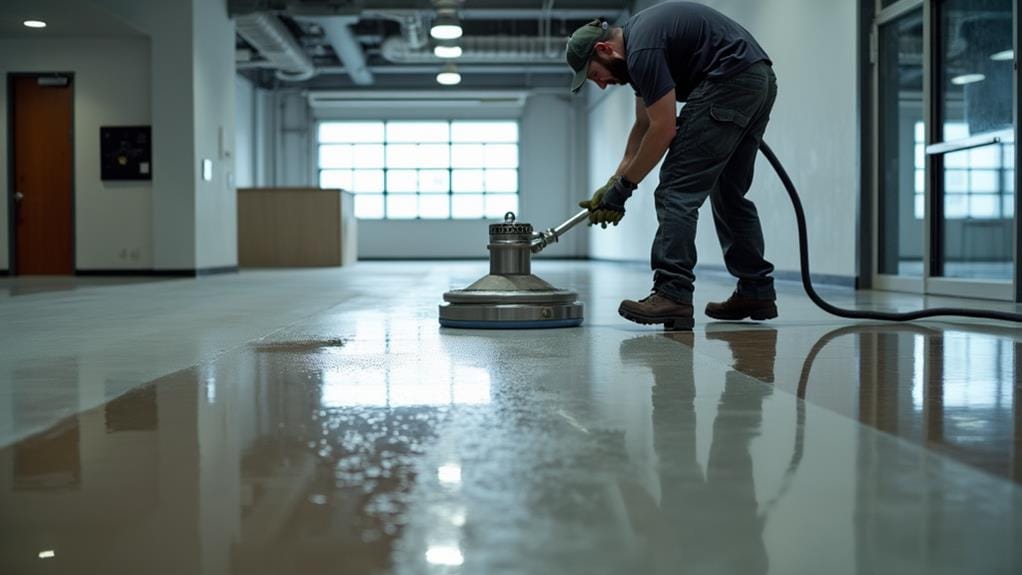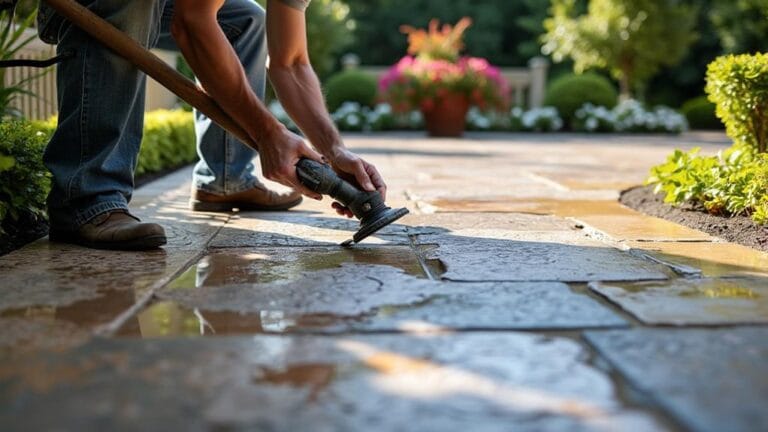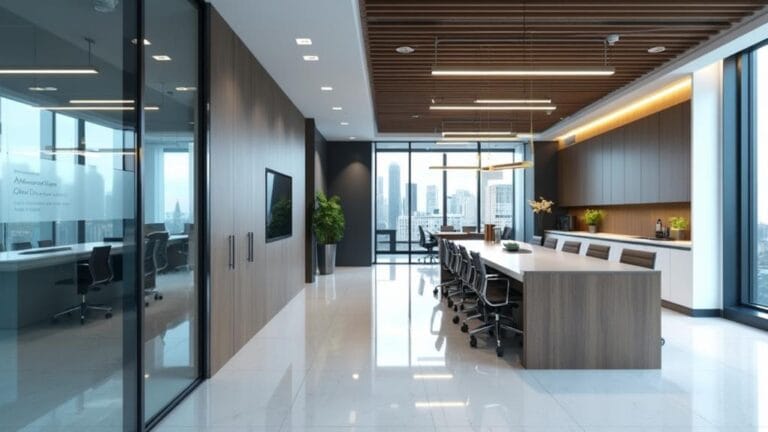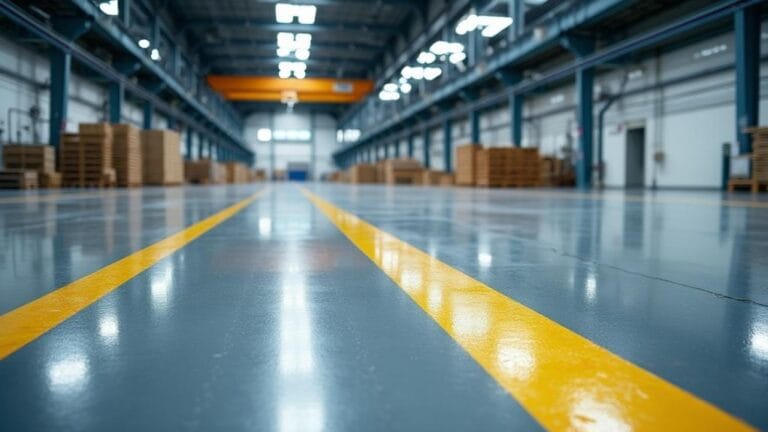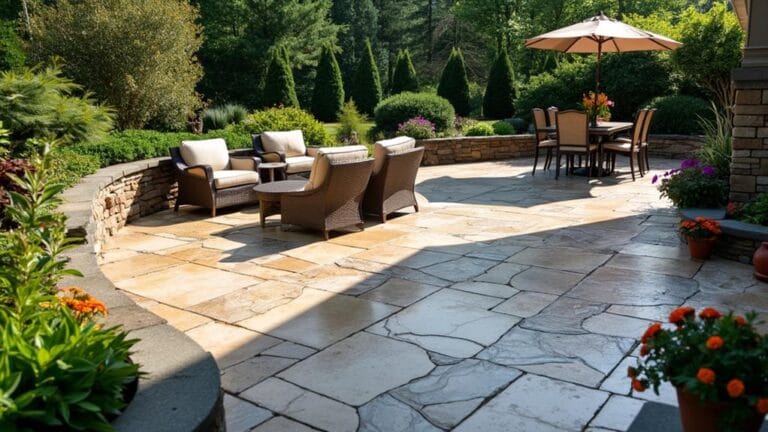5 Tips for Finishing and Repairing Commercial Floors
For effective commercial floor repair and finishing, we need to start with thorough surface preparation, ensuring the base is clean and smooth. Next, use high-quality, durable materials like epoxy coatings for better resilience. Crack filling with epoxy or polyurethane fillers will prevent further damage. Applying the right sealants, chosen based on your floor material, will protect against wear and tear. Finally, maintaining a consistent cleaning schedule and using proper cleaning agents will prolong the floor’s life. Let’s investigate these tips more in-depth to keep your floors looking flawless and functioning at their best.
Surface Preparation
When it comes to commercial floor repair, proper surface preparation is fundamental to achieving lasting results. We can’t stress enough how important it is to start with a clean, smooth base. First, we need to apply effective sanding techniques. Sanding removes old finishes and creates a rough surface that new materials can adhere to better, which is particularly significant before utilizing crucial tools for concrete leveling to guarantee a successful repair. We recommend using a floor sander for large areas, assuring even abrasion across the entire surface. It’s imperative to work methodically, gradually increasing grit levels to achieve the desired smoothness.
Next, we tackle any uneven spots using leveling compounds. These are key for filling in gaps, cracks, and dips that could compromise the durability of the final floor. Applying leveling compounds involves mixing the solution to the right consistency and spreading it over the prepared floor with a trowel or leveling tool. We should let it cure completely, adhering to the manufacturer’s instructions to confirm it sets properly.
Choosing the Right Materials
With the surface properly prepared, our next step is selecting the right materials for the job. It’s essential we focus on material durability to guarantee the floor withstands high traffic and wear over time. Utilizing options like polyurethane foam for leveling can improve stability and longevity. Durability means fewer repairs and a longer lifespan, making it a vital factor in our decision-making process.
When we consider materials, we must balance cost considerations with quality. While it’s tempting to opt for the cheapest option, investing in higher-quality materials can save us money in the long run by reducing repair and replacement frequencies. For instance, epoxy coatings might have a higher upfront cost than standard paint, but their resilience against chemicals and heavy use makes them a more economical choice over time.
Let’s not forget the importance of maintenance requirements. Some materials might require frequent upkeep, adding to overall costs and effort. By choosing materials with lower maintenance needs, we streamline our operations and save resources.
Effective Repair Techniques
Effective Repair Techniques
Diving into effective repair techniques, we can tackle floor damage more efficiently and guarantee a professional finish. First, let’s address crack filling. Cracks not only ruin the aesthetics but can likewise lead to further deterioration if left untreated. Using high-quality epoxy or polyurethane fillers helps to assure a seamless repair. We start by cleaning out any debris from the cracks, then apply the filler carefully, smoothing it out to align with the rest of the floor. Employing durable materials, such as polyurethane foam, can improve the longevity and stability of the repairs.
Next, surface leveling is vital for maintaining a safe and even walking area. Uneven surfaces can cause tripping hazards and wear out quickly. To level a surface, we first identify all the low spots using a straight edge. After marking these areas, we apply a self-leveling compound. This compound spreads out evenly, filling in all dips and creating a smooth, flat surface. Remember, thorough preparation is half the battle; make certain the floor is clean and free of any lingering dust before applying the compound.
Applying Sealants
Having tackled effective repair techniques, let’s now shift our focus to applying sealants, a fundamental step in preserving floor longevity and appearance. First, we need to choose the right sealant type for our floor. Whether we’re dealing with vinyl, hardwood, or tile, different sealant types like acrylic, polyurethane, and epoxy offer various benefits. Acrylic sealants dry quickly and are great for high-traffic areas, while polyurethane provides a durable, protective layer that resists wear and chemicals. Epoxy sealants are excellent for industrial settings because of their high resistance to abrasion and chemicals.
Once we’ve selected the appropriate sealant, let’s discuss application methods. The floor surface should be clean and dry before starting. For an even application, we can use a roller or a brush, depending on the floor size and sealant consistency. We’ll begin at the far corner of the room and work our way toward the exit to avoid stepping on freshly applied sealant. It’s essential to apply the sealant uniformly, avoiding puddles and streaks. After the first coat dries, a second coat is often recommended for added protection. Always follow the manufacturer’s drying time instructions to guarantee optimal results.
Maintenance Strategies
Proper floor maintenance is critical to extending the life and appearance of our commercial floors. To do this effectively, we need a well-thought-out approach. Consistent cleaning schedules should be our top priority. Regularly scheduled cleanings prevent dirt and grime from accumulating, which can lead to premature wear and tear. Here’s how we can keep our floors in top shape:
- Create a Routine: Define a cleaning schedule that specifies daily, weekly, and monthly tasks. This helps guarantee nothing slips through the cracks.
- Use the Right Products: Choose cleaning agents that are appropriate for the specific material of our floors. This prevents damage from harsh chemicals.
- Wear Assessment: Regularly check high-traffic areas for signs of wear and tear. This allows us to address minor damage before it becomes a major issue.
Performing a regular wear assessment allows us to spot potential problems early. For instance, if we notice excessive wear in certain areas, we can adapt the cleaning schedules or even consider adding protective mats. It’s all about maintaining a balance between preventive measures and routine upkeep. Adhering to these strategies guarantees our floors remain durable and visually appealing for years to come.
Frequently Asked Questions
How Do Seasonal Weather Changes Affect Commercial Floor Performance?
Seasonal weather changes definitely impact commercial floor performance. We understand it’s essential to take into account seasonal humidity and temperature fluctuations. High humidity can cause floors to expand, leading to buckling or warping, while low humidity might make them contract, creating gaps. Temperature fluctuations can aggravate these effects, causing further damage or wear. By monitoring and managing these variables, we can help maintain the floor’s integrity and longevity.
What Safety Gear Should Be Used During Floor Finishing and Repair?
Ironically, finishing commercial floors isn’t just about making them shiny; it’s about our safety too. We should always wear safety goggles to protect our eyes from dust and chemicals. Don’t forget those protective gloves to prevent burns and cuts. Respirator masks are crucial to avoid inhaling harmful fumes, and knee pads help us stay comfortable and injury-free during those long hours on our knees. Safety first, right?
Can Commercial Floors Be Environmentally Friendly and Sustainable?
Absolutely, commercial floors can be environmentally friendly and sustainable. By using eco-friendly materials like recycled content or low-VOC finishes, we reduce environmental impact. Adopting sustainable practices such as efficient installation methods and routine maintenance can extend the floor’s life, minimizing waste. We need to prioritize these choices to guarantee our flooring solutions are not only durable but likewise kind to the planet. Let’s make responsible decisions together!
How Do You Prevent Discoloration Over Time in High-Traffic Areas?
To prevent discoloration over time in high-traffic areas, we need to focus on color retention techniques and effective surface treatments. Applying high-quality sealants and protective coatings can shield the floors from wear and UV damage. Regular maintenance, such as cleaning with non-abrasive solutions, likewise helps preserve color. Furthermore, using entrance mats reduces dirt and moisture, preventing discoloration. Adopting these measures keeps our floors looking vibrant and new longer.
What Are the Best Practices for Disposing of Old Flooring Materials?
For the best practices in disposing of old flooring materials, we should investigate recycling options and adhere to disposal regulations. Let’s recycle what we can to reduce landfill waste. Many materials, like certain types of carpets and tiles, are recyclable at special facilities. Confirm we’re familiar with local disposal regulations, as improper disposal can lead to hefty fines. By staying informed, we can responsibly manage waste and contribute to sustainability.

